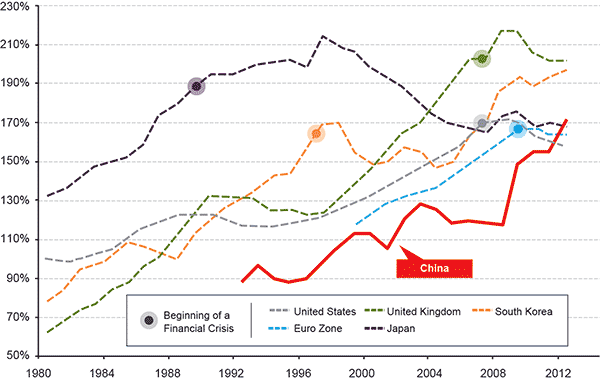Debt has soared there in recent years and has found it's way into a "shadow" financial system apart from the government controlled enterprises. From that blog:
It's likely that bursting bubbles in Asia will be the trigger for a larger world-wide financial bust. Asian bubbles include: China's credit market bubbles (official and shadow markets), dramatic, China and Hong Kong's property/debt bubbles, Thailand's property/debt bubble, Australia's property and debt bubbles, and inflated emerging market equity/bond markets all threaten a similar repeat of the Asia Crisis of 1997. When bubbles burst, banking system crises and currency crises are sure to follow. Capital flight from emerging markets have already started and will aggravate the problems. So, get ready for huge financial turmoil in the coming months.
Maybe I'm a little early in my prediction. You could say that I'm on "debt-crisis watch." In my opinion, the nexus of the next wave of the financial crisis may very well come from China (or Japan).
Now, from Guggenheim Partners,
comes a brief article and a fascinating chart showing the rise of debt
in countries that subsequently had financial crises. You can see from
the chart that China may very well be reaching a level that has marked
financial crises in other countries. Some people peg China's debt level at 200% of GDP, not the 170% shown on the graph. The Chinese themselves might not even know!
 |
| Non-Financial Debt to GDP |
From the Guggenheim article, they go on to explain:
A rapid increase in private sector leverage in a relatively short period of time often presages major financial crises. Historical examples include the collapse of the Japanese property bubble in 1990, the financial crisis in South Korea in 1997, and the most recent crises in the United States, Britain, and the euro zone, which all happened after private sector debt surged to or above 170 percent of GDP. Chinese private sector leverage has reached this significant level. Over the past four years, non-financial private sector debt in China has more than doubled, primarily driven by massive corporate borrowing endorsed by government officials to maintain economic growth rates. Although the recent data show signs of a stabilization in the Chinese economy, the elevated debt burden should continue to cast doubt over its growth sustainability.
No comments:
Post a Comment
Please send me your message or comments. Thanks in advance.